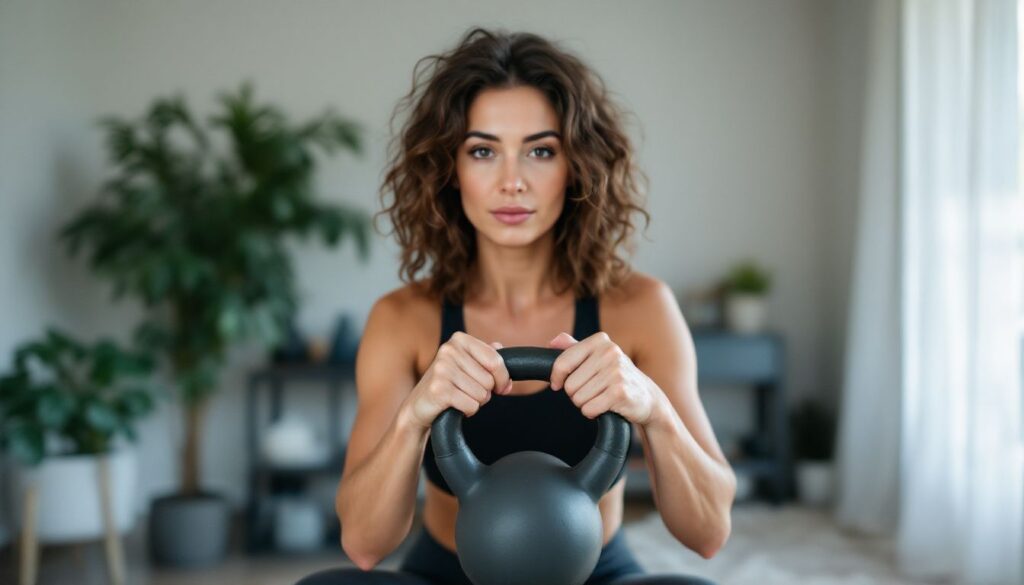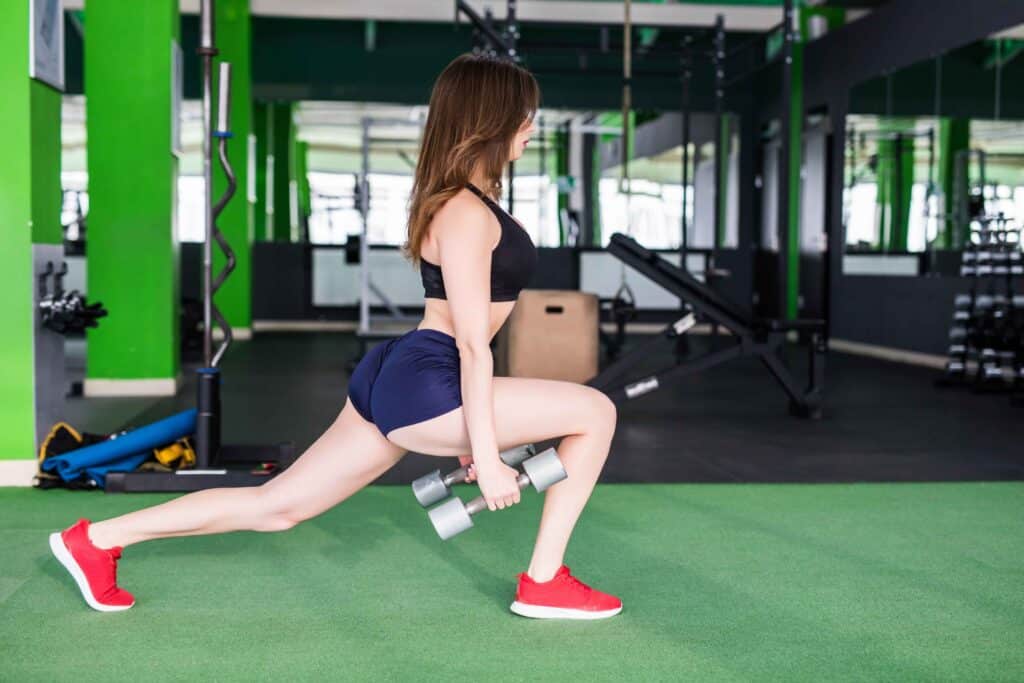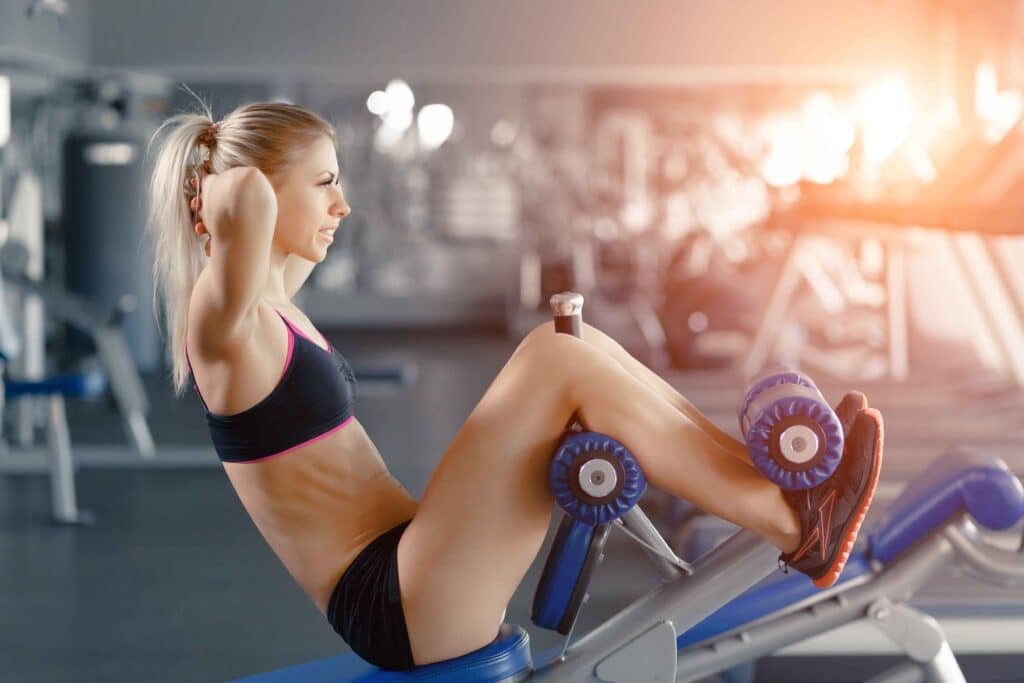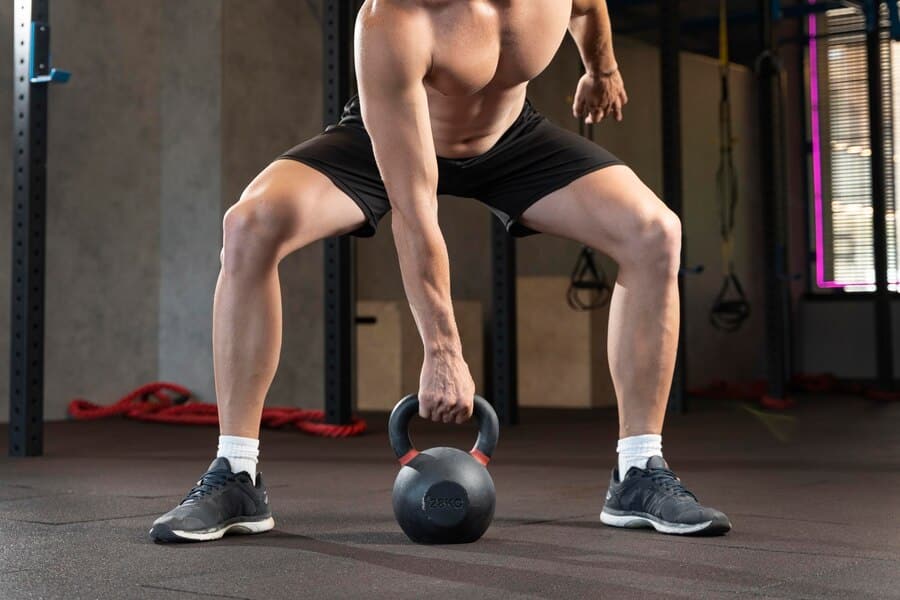Are your glutes not growing as you’d like? A kettlebell glute workout targets your butt muscles effectively. This guide shares the best kettlebell exercises for a stronger booty.
Start building today.
Key Takeaways
- Effective Exercises: Use kettlebell swings, goblet squats, and Bulgarian split squats to build strong glutes. Beginners should start with a 26-pound kettlebell for women and 35 pounds for men.
- Advanced Moves: Add double kettlebell front squats and Turkish get-ups to challenge your muscles. These exercises improve strength, balance, and core stability.
- Workout Design: Combine swings with squats or try the 10-10-10 Glute Burn Challenge. Consistent workouts with increasing reps and weights help grow your booty.
- Benefits: Kettlebell training enhances muscle symmetry, increases functional strength, and boosts your metabolism. This leads to a stronger, more toned lower body.
- Proper Form: Always maintain correct form to prevent injuries. Keep your back straight, hinge at the hips, and gradually increase the weight for best results.
Essential Kettlebell Exercises for Glute Building
To build strong glutes, incorporate essential kettlebell exercises into your routine. These movements target your glute muscles and legs, enhancing strength and size.
Kettlebell Swings
Kettlebell swings are a key move for building strong glutes. They also work your hamstrings and lower back.
- Build Glute Muscles
Swings target the gluteus maximus. This helps shape and strengthen your buttocks. - Enhance Hamstring Strength
The movement activates your hamstrings. Strong hamstrings support your glutes and improve stability. - Improve Core Stability
Swings engage your abs. A strong core aids in better posture and balance. - Boost Metabolic Rate
This exercise increases calorie burn. Higher metabolism helps in fat loss and muscle gain. - Start with Proper Weight
Beginners and women should use a 26-pound kettlebell. Men should start with a 35-pound kettlebell for effective training. - Maintain Correct Form
Keep your back straight and hinge at the hips. Proper form prevents injury and maximizes muscle activation. - Increase Progressive Overload
Gradually add more weight as you get stronger. This ensures continuous glute and strength gains.
Single-Leg Kettlebell Deadlift
Continue building your glutes with the Single-Leg Kettlebell Deadlift. It enhances balance and strength effectively.
- Setup Position
Stand on one foot. Hold a kettlebell in the opposite hand. Keep your back straight and core tight. - Movement Execution
Hinge at the hips. Lower the kettlebell toward the floor. Keep your free leg straight behind you. - Glute Activation
Push your hips forward. Squeeze your gluteus maximus at the top. This maximizes glute engagement. - Balance Improvement
Perform slowly to maintain stability. Use a mirror to check your form. This helps with muscle symmetry. - Weight Adjustment
Start with a light kettlebell. Gradually increase the weight as you gain strength. This ensures progressive overload. - Common Mistakes
Avoid rounding your back. Keep your knee slightly bent. Proper form prevents injury. - Repetition Scheme
Aim for 3 sets of 10 reps each leg. Rest 60 seconds between sets. Consistency boosts results.
Goblet Squat
Goblet Squats are great for building strong glutes. They use kettlebells to enhance your workout.
- Hold the Kettlebell Properly: Grip the kettlebell by the handles close to your chest. This forward weight positioning emphasizes the gluteus maximus muscle.
- Set Your Stance: Place your feet shoulder-width apart. This stance targets the lower limbs and quads effectively.
- Perform the Squat: Bend your knees and hips to lower into a squat. Keep your back straight and chest up to maintain balance.
- Reach Parallel Depth: Lower until your thighs are parallel to the ground. This full squat position maximizes glute activation.
- Drive Upwards: Push through your heels to stand back up. Engaging your legs and glutes ensures proper strength training.
- Maintain Proper Form: Keep your knees aligned with your feet. Proper form protects your knees and enhances muscle symmetry.
- Incorporate into Workouts: Add Goblet Squats to your 10-minute glute workout. Consistency boosts hypertrophy and strength.
Bulgarian Split Squat with Kettlebell
Bulgarian Split Squats with kettlebells target the glutes and quadriceps. They also enhance core strength and balance.
- Hold the kettlebell: Grip the kettlebell close to your chest with both hands.
- Position your feet: Stand a few feet ahead of a bench or chair.
- Place your rear foot: Set one foot behind you on the bench.
- Lower your body: Bend your front knee until your thigh is parallel to the ground.
- Align your knee: Ensure your front knee stays above your ankle.
- Rise up: Push through your front heel to return to the starting position.
- Repeat the exercise: Perform 10-12 repetitions on each leg.
Kettlebell Snatch
Kettlebell Snatch builds strong glutes and boosts your fitness. It uses free weights for effective strength exercises.
- Targets Glutes: Works the gluteus minimus and other gluteal muscles for a toned backside.
- Enhances Heart Rate: Combines cardio with strength, improving overall heart health.
- Builds Grip Strength: Holding the kettlebell sharpens your forearm and grip strength.
- Improves Shoulder Stability: Engages shoulders and elbows for balanced muscle growth.
- Boosts Functional Strength: Increases everyday strength, useful for activities like running and lunges.
- Uses Compound Movements: Engages multiple muscle groups, making workouts efficient.
- Increases Metabolic Rate: Burns more calories, aiding in fat loss and muscle gain.
- Targets Fast-Twitch Fibers: Develops explosive power through ballistic movements.
- Suitable for All Levels: Adaptable with different weights, guided by a personal trainer if needed.
- Enhances Balance: Strengthens stabilizer muscles, improving overall balance and coordination.
Advanced Kettlebell Movements for Glute Development
Advanced kettlebell exercises take your glute workouts to the next level. These moves challenge your muscles and build strength for better results.
Double Kettlebell Front Squat
Double Kettlebell Front Squats are excellent for building strong glutes and legs. They also enhance grip strength and overall power.
- Choose the Right Weight: Select two kettlebells weighing 26, 35, or 52 pounds. Pick a weight that challenges you but allows proper form.
- Proper Grip: Hold a kettlebell in each hand at shoulder height. Keep your elbows high to stabilize the weights.
- Stance: Stand with your feet shoulder-width apart. Point your toes slightly outward for better balance.
- Execute the Squat: Bend your knees and hips to lower into a squat. Keep your back straight and chest up.
- Maintain Form: Ensure your knees track over your toes. Do not let them cave inward.
- Rise Up: Push through your heels to return to the starting position. Keep the kettlebells steady throughout the movement.
- Breathing: Inhale as you lower down. Exhale while pushing back up.
- Repetitions: Aim for 3 sets of 10 reps. Adjust based on your strength level.
- Safety Tips: Start with lighter weights to master the form. Gradually increase the weight as you gain strength.
Turkish Get-Up
Moving from the double kettlebell front squat, the Turkish Get-Up adds more challenge. It boosts strength and balance effectively.
- Full-Body Workout: The Turkish Get-Up engages multiple muscle groups. It works glutes, shoulders, and core, making it a compound exercise.
- Enhances Stability: This move improves balance and motor control. Proper form ensures stability, reducing injury risk.
- Builds Glute Strength: Performing the Turkish Get-Up targets the glute muscles deeply. It helps in developing a strong and rounded booty.
- Increases Mobility: The exercise promotes better joint movement. It enhances hip and shoulder mobility, essential for overall fitness.
- Safe Technique: Certified trainers teach correct positioning. Following their guidance avoids strain and ensures effective workouts.
- Functional Strength: This movement mimics real-life actions. It builds practical strength useful for daily activities and other exercises.
- Improves Coordination: Coordinating movements in the Turkish Get-Up boosts overall body coordination. It leads to smoother and more controlled movements.
Single-Leg Romanian Deadlift (RDL)
The Single-Leg Romanian Deadlift (RDL) builds strong glutes. It also improves balance.
- Starting Position: Hold a kettlebell with both hands. Beginners should use a 26-pound weight.
- Stance: Stand on one leg. Keep the other leg slightly bent behind you.
- Movement: Bend at the hips. Lower the kettlebell towards the floor. Keep your back straight.
- Return: Lift the kettlebell back up. Squeeze your glutes at the top.
- Repetitions: Do 10 reps on each leg. This helps in muscle symmetry and balance.
- Benefits: Engages glutes, hamstrings, and core. Enhances functional strength for runners.
- Integration: Add RDLs to your weight room routine. Combine with other compound exercises like deadlifting and squatting.
Designing Your Kettlebell Glute Workout
Choose a workout that fits you, like combining swings with squats or trying the glute burn challenge. A solid plan helps build strong glutes using kettlebells effectively.
Swing and Squat Workout
This workout pairs kettlebell swings with squats to build your glutes. Complete four rounds, increasing reps each time.
- Kettlebell Swings
- Use a medium kettlebell (12-20 lbs).
- Stand with feet shoulder-width apart.
- Swing the kettlebell between your legs and up to chest level.
- Engage your glutes and keep your back straight.
- Goblet Squats
- Hold a medium-heavy kettlebell (15-25 lbs) at your chest.
- Squat down until your thighs are parallel to the floor.
- Keep your knees behind your toes and chest up.
- Deadlift Squats
- Place two kettlebells on the ground.
- Bend at the hips and knees to grab the kettlebells.
- Stand up by driving through your heels and squeezing your glutes.
- Lower the kettlebells back to the ground with control.
- Increase Reps Each Round
- Start with 10 swings and 10 squats in the first round.
- Add 5 reps to each exercise in each subsequent round.
- Maintain proper form throughout all reps.
- Rest Between Rounds
- Take a 60-second break after each round.
- Use this time to hydrate and prepare for the next set.
Swing, Squat, and Carry Routine
The Swing, Squat, and Carry Routine builds strong glutes and raises your heart rate. It also boosts your grip and improves overall fitness.
- Kettlebell Swings: Perform 15 swings to activate your glutes and flexors. Swings enhance cardiovascular conditioning and strengthen your muscles.
- Goblet Squats: Complete 12 squats while holding the kettlebell at your chest. This move targets the bony pelvis and glute muscles, improving balance and muscle symmetry.
- Farmer’s Carry: Carry two kettlebells for 30 seconds. This exercise boosts grip strength and functional strength, supporting overall fitness.
- Kettlebell Snatches: Do 10 snatches on each side. Snatching engages your glutes and increases your metabolic rate, aiding in fat loss.
- Deadlifts: Perform 12 deadlifts to strengthen your hamstrings and glutes. Deadlifts improve muscle balance and enhance your functional strength.
Next, explore advanced kettlebell movements to further develop your glutes.
10-10-10 Glute Burn Challenge
The 10-10-10 Glute Burn Challenge is part of the best intermediate kettlebell glute workout. Push your strength with this AMRAP format in 10 minutes.
- Kettlebell Swings
Do 10 swings. Engage your glutes each swing. - Goblet Squats
Perform 10 squats. Hold the kettlebell close to your chest. - Single-Leg Romanian Deadlifts
Complete 10 reps per leg. Balance and activate your glutes. - Pistol Squats
Do 10 pistol squats each side. Use support if needed. - Bulgarian Split Squats
Execute 10 splits per leg. Keep your torso upright.
Continue these exercises in rounds. Aim to complete as many rounds as possible in 10 minutes.
Benefits of Kettlebell Training for Glutes
Kettlebell training offers many benefits for your glutes, helping you achieve a stronger and more toned lower body—read on to find out how.
Enhances Muscle Symmetry and Balance
Balanced kettlebell exercises build muscles evenly on both sides. This symmetry helps align the pelvis and spine correctly. Proper alignment reduces hip and lower back pain. Strong glutes support your body and improve posture.
Using barbells alongside kettlebells can enhance balance further. Squatted movements target each side equally, promoting stability. Balanced muscle growth prevents imbalances that can cause injuries.
Consistent training ensures both sides develop harmoniously.
Improves Functional Strength
Kettlebell workouts target large muscle groups in the glutes. This builds functional strength you use every day. Strong glutes help you lift, bend, and move more efficiently. Kettlebell training also boosts grip strength and power.
These improvements enhance your overall physical performance and make daily activities easier.
Increases Metabolic Rate
Intense kettlebell workouts boost your metabolism. Exercises like swings and squats use large muscles. This increases energy use throughout the day. Fast-twitch muscle fibers burn more calories during and after workouts.
Better heart health from kettlebell training keeps your metabolism high. Higher metabolic rates help you burn fat faster and maintain muscle mass.
Tips for Maximizing Glute Gains with Kettlebells
To grow your glutes, gradually increase the kettlebell weight you use. Keep your movements precise and change your exercises often for the best results.
Progressively Increase Weight
Start with a kettlebell that matches your strength. Beginners and women should use a 26-pound kettlebell. Men should start with 35 pounds. As your muscles get stronger, add more weight.
This challenges your glutes and helps them grow.
Increasing the weight gradually ensures continuous progress. Use progressive overload to build bigger, stronger glutes. Track your lifts and add weight regularly. This method leads to consistent gains and effective booty-building results.
Focus on Proper Form
Maintain proper form to avoid injuries. Correct positioning and balance are crucial. Each movement should be precise to ensure safe and effective glute workouts.
Kettlebells enhance core stability. Use them with good form for the best results. Danielle Gertner notes they are beginner-friendly. Proper technique maximizes benefits and prevents strain.
Incorporate Variety and Consistency
Add weight to kettlebell exercises to challenge your glutes. Six certified trainers recommend increasing repetitions over time. Trim rest times between sets to boost intensity. Mixing weights, reps, and rest keeps workouts varied.
Consistent training leads to steady muscle growth. Use different exercises to target all glute muscles effectively.
Conclusion
Kettlebell workouts build strong, shapely glutes. They work for everyone, from beginners to advanced. Use the exercises and routines we shared to see results. Stay consistent and focus on good form.
Strong glutes boost your strength and protect against injuries. Start your kettlebell journey today and achieve your booty goals.
FAQs
1. What does the Ultimate Kettlebell Glute Workout Guide include?
It includes a clear plan using kettlebells to build your glutes. You’ll find exercises, routines—and tips for booty-building success.
2. How often should I do the kettlebell glute workouts?
Aim for three to four times a week. This schedule helps your muscles recover and grow stronger over time.
3. Do I need special equipment for the workout guide?
Only a kettlebell is needed. Choose a weight that matches your strength level—no other gear required.
4. Is the Ultimate Kettlebell Glute Workout Guide suitable for beginners?
Yes, it’s perfect for all levels. The guide starts with simple moves and gradually increases in difficulty as you get stronger.






